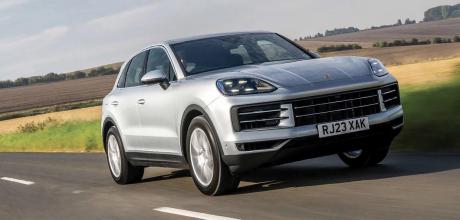2024 Porsche Cayenne
Proving the cheap seats are not what they used to be, the entry-level version of the recently updated Cayenne is utterly brilliant...
Words James Fossdyke
Photography Barry Hayden
RETURN TO BASE
Behind the wheel of the new Cayenne.
If you want a new Cayenne — trust us when we say you do — you’re faced with a fair few choices. For starters, not only can you pick a conventional SUV or a Coupe, but you can opt for the S, complete with its thumping V8, or the only mildly less potent E-Hybrid, with its slightly less ravenous appetite for premium unleaded. There are many more alternatives on the way. Having said all this, you could stay in the (relatively) cheap seats and go for the basic Cayenne.
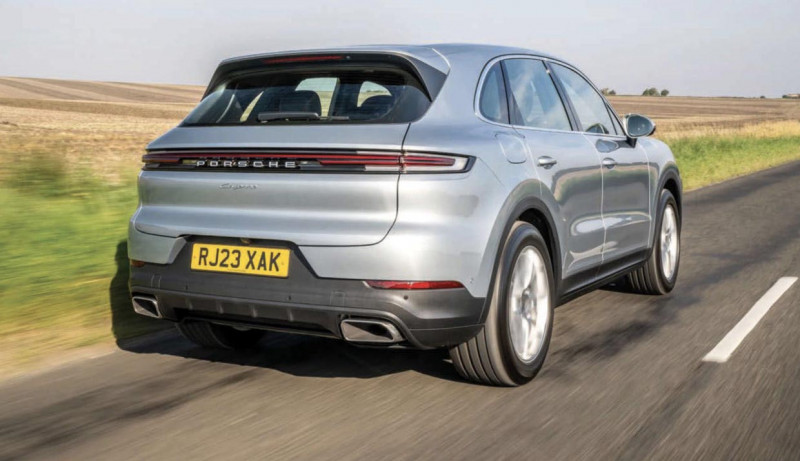
It’s something of an unloved model in the range, without the glamour of its more powerful siblings. With prices starting at less than £68,000, however, is the underdog the unsung hero of the current Cayenne line-up?
Let’s start with that price tag, which makes the stock Cayenne almost £10,000 cheaper than the next-cheapest version: the E-Hybrid. Many of you will be aware of Porsche’s modus operandi of keeping specification more or less the same as you climb the Cayenne range, meaning it’s fair to say the E-Hybrid’s hybrid system is pretty much all you’re getting for the extra spend. And even if it wasn’t, ten grand would buy you a good number of optional extras to make up the difference.
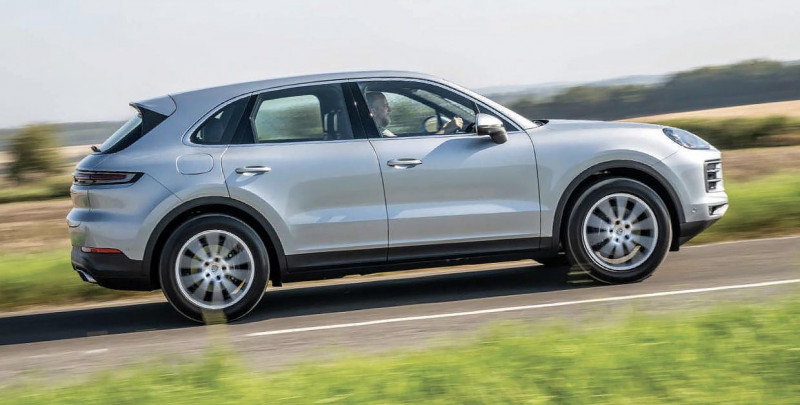
In the event, though, you could happily rub along with a completely entry-level version of this Porsche cargo carrier. As is the case with all other new Cayennes, you get an all-new dashboard loaded with a fully digital instrument display and the latest-generation Porsche Communication Management touchscreen user interface. You also get the same toggle-style gear selector as you’ll find in the Taycan. The switch (you can barely call it a lever) is positioned by the steering wheel. This, in turn, has freed up space in the cabin for the new climate control panel, which is down on the centre console.
In truth, none of these changes equate to a masterclass in ergonomics, and they certainly haven’t transformed the Cayenne driving experience, but they do go a long way to making this Porsche feel more modern. That said, we’d forgotten the first-generation E3 Cayenne was six years old when the facelift version was unveiled for the 2024 model year. At a point some brands would feel the need to bring out a whole new model, Porsche simply has to make a few changes to the cabin.
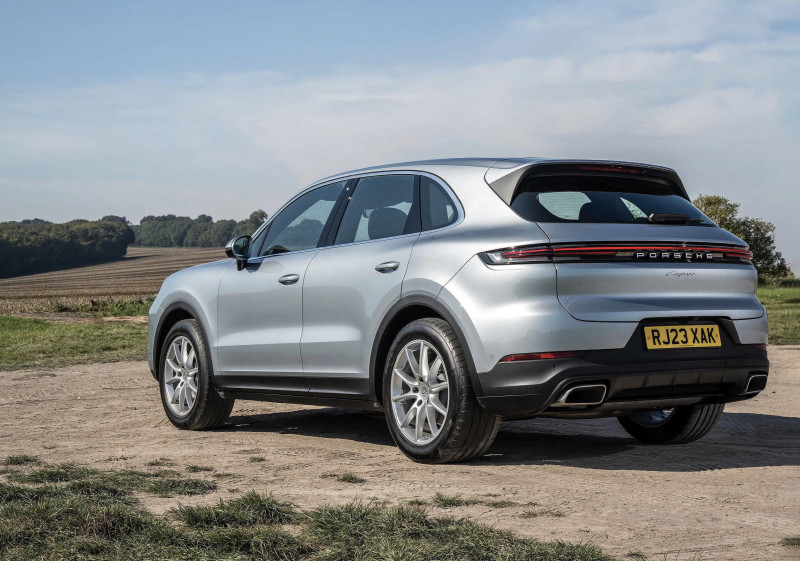
This is testament to just how premium this Porsche really is. Even in its cheapest form (with a price tag of less than £70,000, remember), the Cayenne feels just as upmarket as any other luxury SUV, but it’s a long way ahead of the competition. As we’ve come to expect from our favourite manufacturer, every switch feels brilliantly machined and engineered. All the materials are first-rate and the standard partial leather interior is more than adequate, although some of the optional finishes take the Cayenne’s cockpit from upmarket to unparalleled. Even so, this isn’t the sexiest or the most stylish of interiors — there’s a decidedly Germanic whiff of function over form in here, but changes to the Cayenne cabin have somewhat improved the balance. We’re particularly fond of the optional wood-and-bronze colour schemes on offer, which give the dash a touch of class. The upshot is that this entry-level Cayenne never makes you feel as though you’re in a cheap facsimile of the real thing.
You will, however, feel as though you’re in the spacious seats. Both the Coupe and SUV versions of the Cayenne are roomy in the extreme, with huge amounts of space in both the front and rear. There’s plenty of adjustability and headroom for the driver, along with the typically impressive Cayenne driving position. Elbow room isn’t too shabby, either. Further back, this Porsche isn’t quite as generous as a long-wheelbase limousine, but it’s easily a match for the average executive saloon.
Even passengers well over the six-foot mark won’t get too cramped when spending hours back there. And while the Coupe has marginally less headroom than the SUV, there’s enough space to keep things comfortable for most occupants.
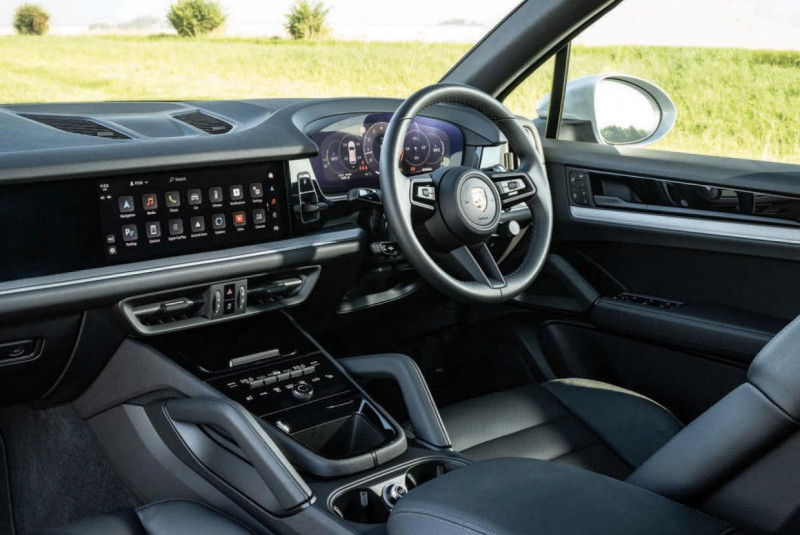
Then there’s the luggage area, which is nothing short of cavernous. Whereas those who choose the E-Hybrid have to ‘make do’ with a 545-litre load area (on account of the hybrid system), the standard Cayenne gets the full 698 litres, which is a big uplift. Admittedly, there’s no seven-seat option, but working on the principle it’s better to have a big boot than seats adults can’t easily use, this no great loss. And if you only need to carry one passenger, the Cayenne’s rear seats can be folded down to achieve a whopping 1,708 litres of capacity.
POWER PLAY
The real distinction between the cheapest Cayenne and its more expensive siblings is the engine. In essence, the three-litre petrol V6 is the same turbocharged engine you get in the Cayenne E-Hybrid, except it doesn’t have the assistance of an electric motor. And while the 348bhp output — a 13bhp increase on the pre-facelift E3 — might look slightly paltry when compared to the E-Hybrid’s 464bhp, it isn’t to be sniffed at. In fact, with a zero-to-62mph time of six seconds flat, the base Cayenne accelerates faster than a Volkswagen Golf GTI. And, if you option the Sport Chrono pack fitted to our test car, you can shave another three tenths from that time. You don’t have to worry about cruising on the autobahn, either, because the Cayenne tops out at 154mph. Put it this way, while this might be the least powerful model in the Cayenne stable, it’s a bit like being the poorest person on The Sunday Times Rich List. Everything is relative, friends. On the road, where such things really matter, the Cayenne is more than quick enough to make good progress. Even the aforementioned six-second dash feels fast in a car this big. And because the V6 is a big engine with lots of grunt, it has plenty of poke for overtaking, as well as for nipping in and out of traffic. This Porsche is never out of breath or short on potency.
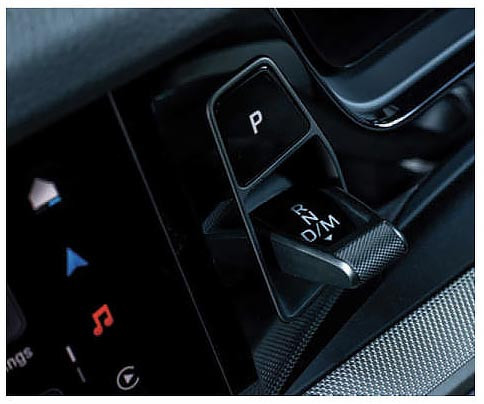
Without the electric motor on hand, the engine won’t quite give you the same shove in the back as you’ll get from the E-Hybrid. Nor will it prove as efficient. Official figures peg the base Cayenne at between 23.3 and 26.2mpg, which makes it barely more economical than the V8-powered S, a model with enough power to achieve the same performance in exchange for a bit less effort. As you’d expect, this level of fuel economy is a long way behind the E-Hybrid. In many respects, it’s a shame the basic Cayenne isn’t a diesel. Porsche’s sister brand, Audi, has some good three-litre V6 diesels kicking about, after all. Alas, in the wake of Dieselgate, Porsche is in no mind to reintroduce derv-drinking engines to its product range. Fuel economy has suffered as a result. Nevertheless, the base Cayenne will get somewhere near its claimed figures on a long run, and when you still only get 30mpg or so from a modern hot hatchback, the trade-off for the Cayenne’s extra space and luxury isn’t such a bad one.
Burning petrol allows the Cayenne to make a great noise. It isn’t ostentatious or rowdy — the V6 soundtrack is smooth, refined — but there’s a pleasant rumble when you give it more than a light prod of power. It isn’t as fruity as the V8 in the S, but this isn’t necessarily a bad thing. The V6 is whisper-quiet, and only when you poke it with a stick does it start to express its full vocal range. It’s at its best slightly lower down, where you get a snarl hinting at the performance hidden deep in the bent-six’s back pocket.
Straight-line speed has never been the Cayenne’s forte, no matter which version you choose, but this is a spectacular SUV that somehow manages to handle like a focused sports car, despite its bulk. On this front, the entry-level Cayenne is at something of an advantage.
Weighing in at just over two tonnes, it’s about four hundred kilos lighter than the E-Hybrid and almost two hundred lighter than the S. The reduction in weight makes a difference, albeit an infinitesimally small one, allowing the standard Cayenne to feel comparatively light on its feet.
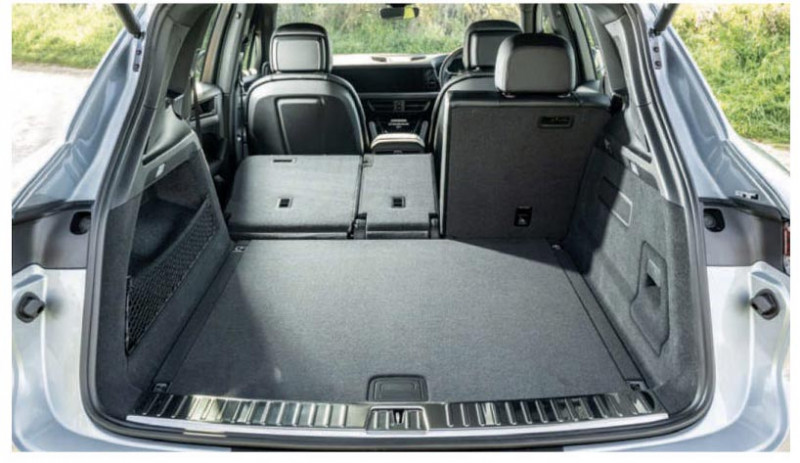
Not that the E-Hybrid or the S feel anything other than sublime. Both models have the trademark Porsche steering feel making every new Cayenne (and, indeed, every other new Porsche) such a class act. Though nobody will mistake the base Cayenne for a lightweight sports car, this is a Porsche which turns into corners keenly — body roll is limited and the grip in corners is bountiful. There’s also just enough feel to let you know what’s going on without ever endangering the ride comfort. And all this is in the default driving mode. Speaking of comfort, Porsche has subtly retuned the Cayenne’s suspension in a bid to make it more supple over bumps, which strikes us as an interesting decision, given the ride quality of the previous entry-level Cayenne, which wafts over imperfections in the road and allows for traversing rough terrain without reducing body roll. The factory’s chassis engineers have done it again, only this time the result is a slightly softer ride. While our test car rode on the optional air suspension, we found it to be an effortless motorway cruiser, soaking up any bump or cat’s eye with aplomb. It was almost as good around town. Yes, the odd pothole makes its presence felt, but this about as harsh as it gets, despite the use of (standard) twenty-inch alloy wheels. Whichever way you cut it, this is very impressive.
Rotating the little switch on the steering wheel will make changes to the car’s chassis settings, but not all are improvements. Opting for Sport mode will sacrifice a little bit of bump absorption in exchange for an equally small improvement in body control and feel for what the wheels are doing, which seems like a fair trade on a good back road. Sport Plus, on the other hand, makes the Cayenne a little bit too firm for UK road use, although it was fine when we tested the Porsche across mainland Europe.
While the Cayenne’s suspension is impressive, we can’t wrap up our review without a word on the brakes. Whereas the E-Hybrid has to balance the demands of regenerative braking and conventional calipers, the standard Cayenne doesn’t have to deal with the same compromise. As a result, the pedal feels far more dependable and consistent, with more natural feedback. Combine this with the reduction in weight and you’re left with excellent stopping power — especially for a vehicle this heavy — giving the driver a great deal of confidence in the Cayenne’s ability to slow quickly and efficiently. This doesn’t necessarily make the base Cayenne a more exciting Porsche than the E-Hybrid or the S. Just because the V6 isn’t as powerful as the V8, for example, doesn’t mean the entry-level Cayenne isn’t great fun to drive — all new Cayennes deliver hugely rewarding seat time. What’s more, with a list price almost £10,000 lower than that of the E-Hybrid, there’s no doubting the excellent value for money delivered by the entry-level model.
And though its V6 engine might not be the last word in performance or economy, it’s more than powerful enough for the majority of drivers to be getting on with. In terms of bang for buck, this Porsche is difficult to beat. The fact of the matter, however, is people tend to buy the car they want, rather than the car they actually need.
Due to there being seemingly more engaging and more exciting versions of the Cayenne available, the lure of bigger power units will be too much for many showroom visitors to resist. This is a shame because the base Cayenne is utterly brilliant on all fronts.
Above Great levels of performance, excellent practicality and a very agreeable price point suggest the new Cayenne will be a big hit in Porsche dealer showrooms
THE LURE OF BIGGER POWER UNITS WILL BE TOO MUCH FOR MANY SHOWROOM VISITORS TO RESIST
Above and facing page Interior features all the trappings of modern Porsche sports cars, such as a fully digital dash, as seen in the Taycan.
JUST BECAUSE THE V6 ISN’T AS POWERFUL AS THE V8 DOESN’T MEAN THE ENTRY-LEVEL CAYENNE ISN’T GREAT FUN TO DRIVE
TECHNICAL DATA
- Model 2024 Porsche Cayenne
- Price From £97,400
- Powertrain 3.0-litre twin-turbocharged V6, eight-speed PDK dual-clutch auto with Porsche Traction Management (PTM), all-wheel drive
- Economy 23.3-26.2mpg
- CO2 emissions 246-275g/km
- Top speed 154mph
- Acceleration 0-100km/h / 0-62mph 6.0 seconds (5.7 with Sport Chrono Package)
- Max Power 348bhp at 5,400-6,400rpm
- Max Torque 369lb ft at 1,450-4,500rpm
- Weight 2,055kg (DIN)
Above Stealthy silver paintwork does its best to avoid drawing attention, unlike the new Cayenne’s specification, which includes a twin-turbo V6 developing 348bhp and 396lb-ft.
Above The looks are fairly unassuming for a new Porsche, but don’t be fooled into thinking the new base Cayenne is basic.
Below With a gigantic 1,708 litres of storage space when the rear seats are folded forward, there isn’t much you won’t fit in the back of this SUV.


